What?
Why visit?
Tallinn’s Art Nouveau buildings are artifacts from the waning days of the Belle Epoque, while their subsequent histories reflect the many changes the city has experienced since then.
Where?
The historic heart of Tallinn. Map.
Tallinn’s Art Nouveau buildings are artifacts from the waning days of the Belle Epoque, while their subsequent histories reflect the many changes the city has experienced since then.
Where?
The historic heart of Tallinn. Map.
IN TALINN, A city touted for its well-preserved Medieval Old Town, stunning Art Nouveau buildings stand out as rare gems that embody the Estonian capital’s more recent historical development.
While Art Nouveau, or Jugendstil as the style is also known, is more prevalent in Helsinki to the north and Riga to the south, here the eclecticism of the small array of buildings reflects the diversity and tensions that shaped the physical character of this Baltic seaport during its final years of stability before decades of upheavals.
 Presented here are six buildings completed in the years before the outbreak of the First World War. Reval, as it was then officially called, was an outpost of the Tsarist Russian Empire, with a local elite of Baltic Germans whose origins dated back to the Middle Ages. Most of the population was ethnically and linguistically Estonian; their national ambitions were awakening but as yet unrealized.
Presented here are six buildings completed in the years before the outbreak of the First World War. Reval, as it was then officially called, was an outpost of the Tsarist Russian Empire, with a local elite of Baltic Germans whose origins dated back to the Middle Ages. Most of the population was ethnically and linguistically Estonian; their national ambitions were awakening but as yet unrealized.Soon, all of that would change, with a history over the twentieth century that witnessed wars, foreign occupations, major demographic shifts, revolutions, and independence gained, lost, and regained.
Architectural history is sometimes presented as a static discipline, focusing on dates of building construction, designers, and original occupants, with historic buildings understood as snapshots of the past frozen for posterity.
Tallinn’s Art Nouveau gems instead suggest a fluidity in which buildings do not stand aloof but are weaved into the historical narrative.
Nuku Puppet Theatre, Lai tänav 1
As Art Nouveau flowered across Europe in the late 19th century, Tallinn stuck with traditional designs. Better late than never, this three-story building for the Nobility Club was among the city’s first in the new style upon its completion in 1907. It blends historicist and new elements such as a Neo-Renaissance balcony contrasted by a sinuously rounded corner facade and roofline.

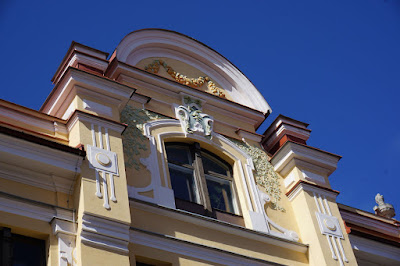
 The Estonia-based designers were Nikolai Thamm the Younger (also known as Tamm) and Baron Arthur von Hoyningen-Huene. The former, like his father, was a St. Petersburg trained architect while the latter was an engineer and Baltic German nobleman.
The Estonia-based designers were Nikolai Thamm the Younger (also known as Tamm) and Baron Arthur von Hoyningen-Huene. The former, like his father, was a St. Petersburg trained architect while the latter was an engineer and Baltic German nobleman.
Where aristocrats once met, today the City’s popular Puppet Theatre entertains the young and young at heart. Ferdinand Veike, who founded the organization and moved it here in 1955, is memorialized by a sculpture near the entrance on Lai Street. The current use is especially apropos as the 1907 building was constructed over the remnants of a German theater (more on that later) destroyed in a 1902 fire.
Reichmann House, Pikk tänav 23-25
When I visited this 1909 apartment building, its exuberant and colorful decorations sparkled despite the gloomy overcast sky above.The building also had Latvian links. Rosenbaum and Boustedt both studied at the Polytechnic Institute in Riga, where many buildings of that era were adorned with works by Volz, who was based there. Bringing his signature sculptural motifs north to Tallinn helped make this an impressive first completed project for the young architect.
Dragon Gallery, Pikk tänav 18
The Reichmann House team reunited to create this five-story apartment building with a ground level and basement store for owner Ferdinand Treublut in 1909-1910. Located across the street from their previous project, here Rosenbaum and Volz designed a full fledged Art Nouveau work, discarding historicist templates. It includes a wide arch-shaped entry with windows at the base, bracketed by Volz’s dragon reliefs and above them statues of ancient Egyptian women and sphinxes projecting from pilasters, accentuating the frame structure. This exemplifies how Art Nouveau architecture combined sensuous artistic details with technical innovations.
It includes a wide arch-shaped entry with windows at the base, bracketed by Volz’s dragon reliefs and above them statues of ancient Egyptian women and sphinxes projecting from pilasters, accentuating the frame structure. This exemplifies how Art Nouveau architecture combined sensuous artistic details with technical innovations.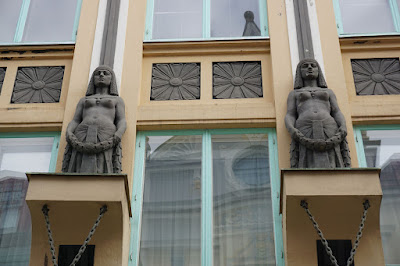 Since the 1980s the old store space has housed an art gallery called Draakoni Galerii (Dragon Gallery), which also serves as an informal name for the much loved building.
Since the 1980s the old store space has housed an art gallery called Draakoni Galerii (Dragon Gallery), which also serves as an informal name for the much loved building.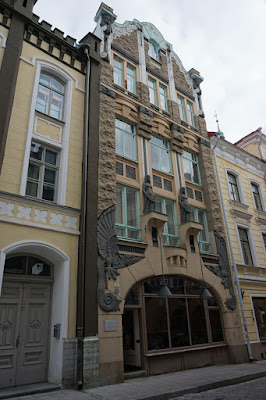
 As for Rosenbaum, his personal story offers contradictions. He designed several more notable Tallinn buildings, including a mausoleum for the Jewish community. However, with changing conditions following the First World War and Estonian independence, he emigrated to Germany in the 1920s where he joined the Nazi Party in 1932.
As for Rosenbaum, his personal story offers contradictions. He designed several more notable Tallinn buildings, including a mausoleum for the Jewish community. However, with changing conditions following the First World War and Estonian independence, he emigrated to Germany in the 1920s where he joined the Nazi Party in 1932.
Pagari One and KGB Prison Cells, Pikk tänav 59
If any single building is a barometer of changes experienced by Estonia over the last 110 years, it may be the Art Nouveau apartment house at Pikk 59. Developed by British expat William Tulip according to plans by architect Hans Schmidt in 1911-1912, this ultra-modern five-story apartment building seemed to signal Tallinn joining the ranks of large, prosperous European cities.
Developed by British expat William Tulip according to plans by architect Hans Schmidt in 1911-1912, this ultra-modern five-story apartment building seemed to signal Tallinn joining the ranks of large, prosperous European cities.

However, with threats to the city during World War I, in early 1917 the state acquired the building to house defense operations. This initiated a long period of use by a succession of Russian, German, Estonian, and Soviet government agencies, most notoriously by the NKVD (later the KGB) from the 1940s to ‘80s when it was infamous for its torture chambers.

With the restoration of independence in 1991, the building was transferred to the Estonian Ministry of Interior, which retained it until 2010. Most of Pikk 59 was converted back to luxury apartments in 2011-2013 by Singaporean businessman Sonny Aswan and ARS Projekt architects, with its condominiums setting local sales price records. Now known by one of its other addresses, Pagari One, the building also includes the KGB Prison Cells museum in the basement, opened in 2017.

Its signature feature is the set of elegant plastered panels, which, according to writings of Estonian architectural historian Karin Hallas-Murula, were produced in St. Petersburg, where Schmidt studied. Otherwise, the aesthetic approach is more subtle, providing texture through a mix of materials, colors, bay windows, and balconies.
However, with threats to the city during World War I, in early 1917 the state acquired the building to house defense operations. This initiated a long period of use by a succession of Russian, German, Estonian, and Soviet government agencies, most notoriously by the NKVD (later the KGB) from the 1940s to ‘80s when it was infamous for its torture chambers.
With the restoration of independence in 1991, the building was transferred to the Estonian Ministry of Interior, which retained it until 2010. Most of Pikk 59 was converted back to luxury apartments in 2011-2013 by Singaporean businessman Sonny Aswan and ARS Projekt architects, with its condominiums setting local sales price records. Now known by one of its other addresses, Pagari One, the building also includes the KGB Prison Cells museum in the basement, opened in 2017.
Its signature feature is the set of elegant plastered panels, which, according to writings of Estonian architectural historian Karin Hallas-Murula, were produced in St. Petersburg, where Schmidt studied. Otherwise, the aesthetic approach is more subtle, providing texture through a mix of materials, colors, bay windows, and balconies.
Estonia Theatre, Estonia puiestee 4
The theater that burned down in 1902 on the site of what is now the Nuku Puppet Theatre was replaced by a new German Theatre in 1910 located outside the Old Town. At the same time, the majority Estonian speaking population did not have a similar facility, but various groups organized to redress this deficiency.They raised funds, secured a free site from the city, and received begrudging approval from Russian officials. Through an international competition, in 1908 they selected a design mixing Classicism and Art Nouveau by Finnish architects Armas Lindgren, a former partner of Eliel Saarinen (see our Helsinki Art Nouveau article for examples of their work), and Wiwi Lönn, Finland’s first female architect to have her own practice. There was not an ethnic Estonian architect who offered a suitable design, but Finns were the next best thing given linguistic and cultural similarities.
The monumental Estonia Theatre, which consists of both a theater and a separate concert hall connected by a central section containing auxiliary spaces including a restaurant, opened in 1913 and has been a national icon ever since. Besides cultural programming, notable events have included the first meeting of independent Estonia’s Constituent Assembly in 1919.
It was rebuilt after the Second World War under architects Alar Kotli and Edgar Johan Kuusik due to major damage from a 1944 bombing. Much of the Art Nouveau character was lost during the reconstruction. Regardless, the overall massing retains the spirit of the original with its double bowed facades.
Passage Building, Sauna tänav 1
The three-story apartment building at the corner of Sauna and Väike-Karja streets has a wide entry portal built as part of a planned Parisian style covered passage designed by Finnish architects Wäinö Palmqvist and Einar Sjöström. Only the end buildings, including this one at Sauna 1, were built in 1914 before the rest of the endeavor was dropped, due to the outbreak of the World War.
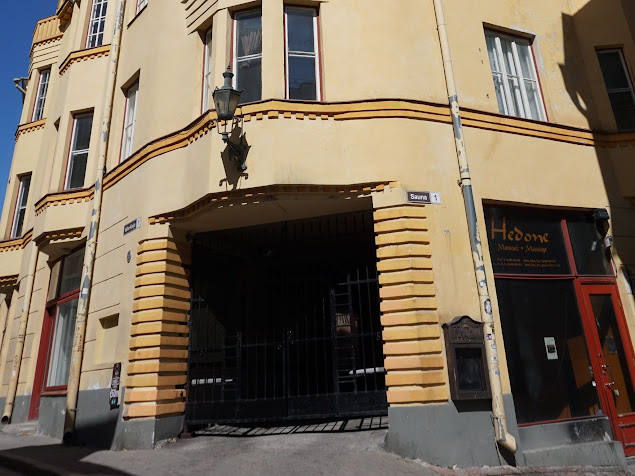
The final drawings for the building, with Art Nouveau details such as arched windows and abstract geometric decoration, were completed by two young Tallinn-based architects, Karl Burman and Artur Perna.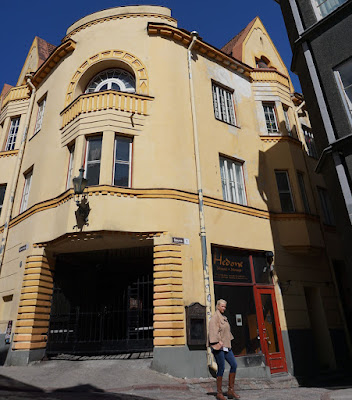 This provides an apt metaphor, portending a shift to the growing importance of local architects in Tallinn that accelerated when the country gained independence after the First World War. Burman in particular personifies this trend.
This provides an apt metaphor, portending a shift to the growing importance of local architects in Tallinn that accelerated when the country gained independence after the First World War. Burman in particular personifies this trend.
The first Estonian professional architect, with Perna close behind, Burman is remembered for using inspiration from Finland and other sources to pioneer a distinctly Estonian national style consistent with its cultural awakening. He also was one of the founders of the Estonian Association of Architects.
As you admire this colorful Art Nouveau work, consider how it and others from that period helped plant seeds that flower in Estonia even today.
About the author:The final drawings for the building, with Art Nouveau details such as arched windows and abstract geometric decoration, were completed by two young Tallinn-based architects, Karl Burman and Artur Perna.
The first Estonian professional architect, with Perna close behind, Burman is remembered for using inspiration from Finland and other sources to pioneer a distinctly Estonian national style consistent with its cultural awakening. He also was one of the founders of the Estonian Association of Architects.
As you admire this colorful Art Nouveau work, consider how it and others from that period helped plant seeds that flower in Estonia even today.
 Jeff Reuben is an urban planner and writer based in New York City. He regularly contributes to the website Untapped Cities.
Jeff Reuben is an urban planner and writer based in New York City. He regularly contributes to the website Untapped Cities.

Comments
Post a Comment
Have you been here? Or are you planning to go? Either way, we would love to hear about it.